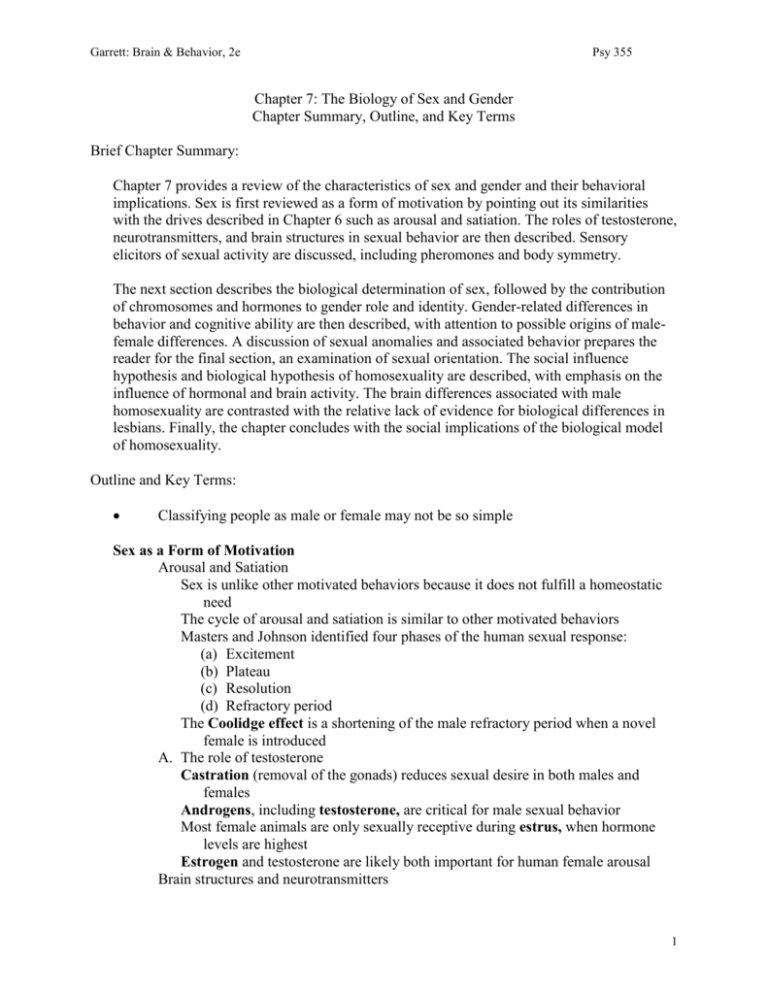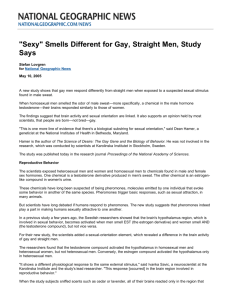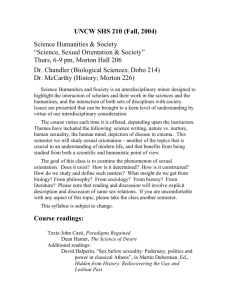
Garrett: Brain & Behavior, 2e
Psy 355
Chapter 7: The Biology of Sex and Gender
Chapter Summary, Outline, and Key Terms
Brief Chapter Summary:
Chapter 7 provides a review of the characteristics of sex and gender and their behavioral
implications. Sex is first reviewed as a form of motivation by pointing out its similarities
with the drives described in Chapter 6 such as arousal and satiation. The roles of testosterone,
neurotransmitters, and brain structures in sexual behavior are then described. Sensory
elicitors of sexual activity are discussed, including pheromones and body symmetry.
The next section describes the biological determination of sex, followed by the contribution
of chromosomes and hormones to gender role and identity. Gender-related differences in
behavior and cognitive ability are then described, with attention to possible origins of malefemale differences. A discussion of sexual anomalies and associated behavior prepares the
reader for the final section, an examination of sexual orientation. The social influence
hypothesis and biological hypothesis of homosexuality are described, with emphasis on the
influence of hormonal and brain activity. The brain differences associated with male
homosexuality are contrasted with the relative lack of evidence for biological differences in
lesbians. Finally, the chapter concludes with the social implications of the biological model
of homosexuality.
Outline and Key Terms:
Classifying people as male or female may not be so simple
Sex as a Form of Motivation
Arousal and Satiation
Sex is unlike other motivated behaviors because it does not fulfill a homeostatic
need
The cycle of arousal and satiation is similar to other motivated behaviors
Masters and Johnson identified four phases of the human sexual response:
(a) Excitement
(b) Plateau
(c) Resolution
(d) Refractory period
The Coolidge effect is a shortening of the male refractory period when a novel
female is introduced
A. The role of testosterone
Castration (removal of the gonads) reduces sexual desire in both males and
females
Androgens, including testosterone, are critical for male sexual behavior
Most female animals are only sexually receptive during estrus, when hormone
levels are highest
Estrogen and testosterone are likely both important for human female arousal
Brain structures and neurotransmitters
1
Garrett: Brain & Behavior, 2e
Psy 355
Several brain structures contribute to sexual behavior in rats
(a) Medial preoptic area (MPOA) – performance
(b) Medial amygdala – response to exciting stimuli
(c) Sexually dimorphic nucleus (SDN-POA) – male sexual activity
(d) Ventromedial nucleus of the hypothalamus (VMN) – female sexual
behavior
Neurotransmitters involved include dopamine, serotonin, and oxytocin
Sensory stimuli in sexual behavior
The nose as a sex organ
(a) Each person gives off a unique odor that can be distinguished by others
(b) Odor may signal genetic differences, including those for Major
histocompatibility complex (MHC) is a group of genes that are important
for immune function
(c) Pheromones are chemicals emitted by animals that affect the behavior of
others.
(d) The human olfactory system can detect about 10,000 odors
(e) Each olfactory neuron has a single odor receptor and the brain detects a
complex odor by the combination of active neurons
(f) Most pheromones are detected by the vomeronasal organ, located in the
nasal cavity but distinct from the olfactory system
Sends projections to the MPOA, VMN, and medial amygdala
Female pheromones can affect the menstrual cycles of other females
Pheromones affect arousal and attractivity
The human vomeronasal organ is diminished
Body Symmetry, Fitness, and Fertility
Body symmetry in males and females leads to higher attractiveness ratings and
is associated with greater sexual activity
More symmetrical individuals are healthier and more fertile
The Biological Determination of Sex
Sex refers to the biological characteristics that divide humans and other animals into
groups of male and female
Gender refers to the behavioral characteristics associated with being male or female
Gender role is the behaviors society considers appropriate for people of a given sex
Gender identity is the sex a person identifies as being
Chromosomes and Hormones
Sex is determined by the sex chromosome carried by the sperm: X for female and
Y for male.
Male and fetuses are identical for the first month, and then the reproductive
organs begin to form
Females (XX)
The primitive gonads become ovaries, where ova develop
Müllerian ducts develop into the uterus, fallopian tubes and inner vagina
No hormonal signal is required to develop the female reproductive organs
2
Garrett: Brain & Behavior, 2e
Psy 355
Males (XY)
The SRY gene signals the primitive gonads to become testes
The testes secrete Müllerian inhibiting hormone to regress the Müllerian
ducts
Testosterone signals the Wolffian ducts to develop into the seminal vesicles,
and vas deferens
The androgen dihydrotestosterone masculinizes the external genitalia
Organizing effects of hormones occur during development and permanently
affect structure (organ and brain sexual differentiation)
Activating effects describe many of the reversible developmental changes that
come about during puberty, such as breast development (girls) and beard
development (boys), and sexual interest
Prenatal Hormones and the Brain
Estrogen, aromatized from testosterone, during fetal development masculinizes
certain parts of the brain
Estrogen may also play a role in feminization
Gender-Related Behavioral and Cognitive Differences
Some Demonstrated Male-Female Differences
Girls have greater verbal fluency and are superior at writing, but not reading
comprehension or vocabulary
Boys have greater three-dimensional visual-spatial rotation skills and broad
mathematical ability, but girls are better at computation
Boys are generally more aggressive
Origins of Male-Female Differences
Cognitive differences are likely influenced by experience, as these differences
have narrowed between boys and girls as gender roles have changed
Murder rates vary considerably across cultures, suggesting a social influence on
aggressive behavior
The difference in mathematical performance has been all but erased in recent
years
A portion of the corpus collosum called the splenium is larger in females,
suggesting greater communication between the hemispheres and thus
enhanced verbal skills
Estrogen may also increase verbal ability
Spatial ability has been linked to testosterone levels and genes on the X
chromosome
Aggression is partially inheritable
Higher testosterone levels are associated with increased aggression but may not
be causal
Sexual Anomalies
A. Male Pseudohermaphrodites
Have testes but other internal and external sex organs are ambiguous
3
Garrett: Brain & Behavior, 2e
Psy 355
Enzyme deficiencies that reduce the amount of dihydrotestosterone result in a
male pseudohermaphrodite whose external genitals are only masculinized at
puberty
Androgen insensitivity syndrome is caused by the absence of androgen
receptors, resulting in retained testes, overall female appearance and female
external genitalia
B. Female Pseudohermaphrodites
Have female internal organs but the external genitals have a masculine or
ambiguous appearance
Congenital adrenal hyperplasia (CAH), excessive androgen production by the
adrenal glands, varies in severity but results in masculinized appearance
C. Sex Anomalies and the Brain
1) CAH women show higher spatial ability, similar to males, “tomboyish”
behavior, and increased sexual interest in other women
2) Androgen insensitive males prefer male sex partners, are feminine in
behavior, and have cognitive abilities similar to genetic females
D. Ablatio Penis: A Natural Experiment
The “neutral-at-birth” theory hypothesizes that rearing is more important than
chromosomal sex or hormones for gender identity
The “sexuality-at-birth” hypothesis argues that sex of rearing is determined by
genital appearance, which reflects the prenatal hormone environment
A boy reared as a girl after his penis was accidentally destroyed in infancy
successfully adopted a male identity later
A similar individual accepted a female identity, but preferred male and female sex
partners equally, and chose “masculine” activities
Sexual Orientation
Homosexual men are called gay; homosexual women are called lesbians
Those who are not exclusively homo- or heterosexual are called bisexuals
Asexuality may also be a legitimate preference
Research does not indicate that gay men are necessarily feminine, or that lesbians are
necessarily masculine
Sexual orientation is distinct from gender identity (gay man still consider themselves
men)
Transsexuals have reversed gender identity and prefer to dress and live as the
opposite sex
The Social Influence Hypothesis
Surmises that homosexuality arises from parental influence, or early sexual
experiences
Homosexuals do have developmental homosexual experiences, such as
experiencing homosexual contact by the age of 18
Recent evidence suggests that these experiences reflect a homosexual
predisposition rather than causes of homosexuality
4
Garrett: Brain & Behavior, 2e
Psy 355
Experience may play a role in bisexuality and influence behavior in
individuals with a weaker genetic predisposition for homosexuality
As children, homosexuals display a higher rate of gender nonconformity – a
tendency to engage in activities associated with the opposite sex
Genes and Sexual Orientation
Homosexuality is higher among the siblings of homosexuals (especially identical
twins) than the rest of the population
Gay men have more gay relatives on the maternal side of the family suggesting
that genes on the X chromosome may play a role
Homosexuality may be linked to epigenetics and the inactivation rate of the X
chromosome in the mother
Hormonal Influence
Homosexuals do not have a shortage or excess of sex hormones
Testosterone administration does not alter sexual preference
Any hormonal influences on sexual preference likely occur before birth
Spontaneous homosexual behavior has been seen in a number of species
including sheep and gulls
Brain Structures
The third institial nucleus of the anterior hypothalamus (INAH 3) has been
found to be twice as large in heterosexual men as in gay men and
heterosexual women
The suprachiasmatic nucleus (SCN) has been shown to be larger in gay men
than in heterosexual men
The anterior commissure was found to be larger in gay men and heterosexual
women than in heterosexual men
Gay men are more similar to women than heterosexual men in performance on
cognitive and spatial tasks
The Challenge of Female Homosexuality
There is no evidence that lesbians have abnormal levels of testosterone or
estrogen
Lesbians perform similarly to heterosexual females on verbal and spatial tests
Two physical characteristics influenced by prenatal hormone levels distinguish
lesbians from heterosexuals
In lesbians, the ring finger is relatively longer than the index finger, as
in men (but not in heterosexual women)
The response to click-evoked otoacoustic emissions is weaker in
lesbians and men than in heterosexual females
Social Implications of the Biological Model
If homosexuality is a choice then civil rights legislation does not apply
because the trait is not “inborn”
If homosexuality is proven to have a biological basis, homosexuals fear that
they will be branded as “defective”
People who believe that homosexuality is inborn are more positive toward
homosexuals than those who believe it is a conscious choice
5






